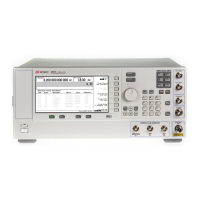E8257D/67D, E8663D PSG Signal Generators Service Guide
Troubleshooting
Self–Test Overview
1-121
Self–Test Overview
A group of tests (self–tests) are embedded in the signal generator’s firmware that can evaluate the condition of the
circuitry on many of the assemblies. Self–tests check hardware performance under controlled conditions, and compare
test results to predetermine limits. If the results fall within the limits the signal generator passes. If the results of one
or more tests fall outside the limits, the self–test routine evaluates the failures and reports the most independent
failure.
Because self–tests are designed to check signal generator hardware, the signal generator does not need to be
calibrated for self–tests to pass. Self–tests are designed with the philosophy that it is better to pass a defective signal
generator than to fail a good one; some failures will pass, rather than be detected and reported. If the signal
generator powers on and self–tests can be run, always start troubleshooting by running self–tests and resolving
reported problems.
How self–test works:
1. When the signal generator is tested at the factory, self–test limits are loaded into the A18 CPU memory from
devices on each assembly, or from fixed files. Most assemblies contain limit information, while microcircuit limits
must be loaded.
2. When the program runs, latches and DACs are set to a known state.
3. An analog mux routes the detected dc signal from the selected test node to the A18 CPU.
4. The A18 CPU compares the detected dc level to the test limit. If the detected value is within the limits, the
A18 CPU reports a pass.
5. If one or more detected values fall outside the limits, the most independent failure is determined and reported.
Independent failures
An example best illustrates independent failures; in this example, there are three assemblies in a series: A1, A2, and
A3. The output of A1 is the input for A2, and the output of A2 is the input for A3. If the output of A1 is bad, A2 and
A3 outputs are also bad. If the output of A2 is bad, the output of A3 is also bad. A file in the signal generator
contains this dependency knowledge for the signal generator to use to identify the most independent failure. If A1, A2,
and A3 self–tests all fail, the signal generator reports A1 as the most independent failure. If A1 passes but A2 and A3
fail, self–test reports A2 as the most independent failure. If A2 passes and A3 fails, self–test reports A3 as the most
independent failure. If two independent failures occur, self–test reports only one failure at a time and reports the
second failure after the first reported failure is repaired.
Troubleshooting procedures in this chapter are based on the most independent failure, and no lower level information
is needed. Although not needed for troubleshooting, the self–test overhead does provide features to view lower level
detailed information about the subroutines, and select specific routines to run. These features include:
• Select/Deselect Test
• Select/Deselect All
• View Details
• Run Highlighted Tests
•Run Selected Tests
• When View Details is selected, the highlighted test’s measured value, lower, and upper limits are displayed.

